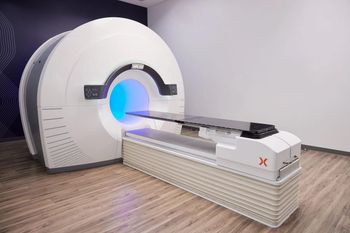
Mobile digital mammography scans stack up to film images
Digital mammography images acquired in a 64-foot van serving Washington residents are as good as mobile film-based images, according to a study from a Seattle breast center.
Digital mammography images acquired in a 64-foot van serving Washington residents are as good as mobile film-based images, according to a study from a Seattle breast center.
Swedish Breast Center's mobile service includes digital and film-based mammographic screening. Digital films may be taken on board and transmitted via rooftop to a physical site for real-time interpretation. (Provided by M. Kelly)
The study, presented at the RSNA on Tuesday, featured a van dubbed the Swedish Breast Care Express-- a deluxe mobile mammography service offered by Swedish Medical Center. The self-contained mobile mammography unit inside the 18-wheeler coach is designed to look like a standard medical office. The service travels to a range of sites, including Native American reservations, senior centers, and ethnic health fairs.
Swedish Medical Center has offered mobile film-based mammographic screening for more than a decade. In a bid to bring state-of-the-art technology to the masses, it began offering digital services in May 2004. Back at the medical center's main campus, both digital and screen-film mammography are performed.
As a quality control exercise, the facility performed a medical audit of all screening mammograms performed between January and December 2004. It compared images taken in the following three categories:
- film-based mobile mammography;
- full field digital mobile mammography (FFDM); and
- film-based and digital images taken at the physical site.
The audit included close to 14,000 mammograms of asymptomatic women in these three groups. Performance measures included recall rates, acuity of BI-RADS assessment codes, cancers detected per 1000 women screened, and positive predictive value for screening.
"We wanted a snapshot of how we were doing with mobile digital," said Dr Mary Kelly, director of medical imaging at Swedish.
It turns out the team is doing very well. Performance measures of mobile digital screening were found to be similar to film-based screening. On some measures, such as recall rates, mobile digital and mobile film-based images were considered as good as images (digital and screen-films) taken at the physical site, according to Kelly. Although performance was marginally better at the physical site in some respects, in general the three groups were very similar.
The findings suggest the mobile digital screening program should be expanded.
"Diffusion of mobile digital screening seems appropriate given the logistical advantages," Kelly said. "Mobile screening programs could become more viable."
Among other advantages, mobile digital screening offers immediacy and the potential for online transmission and interpretation via satellite in remote areas. In the Breast Care Express, images are stored and transmitted via laptop or the retractable rooftop satellite antenna within 15 minutes back to the Swedish Medical Center site. Patients can obtain their results the same day.
Mobile digital screening also allows greater access to subspecialty breast imaging expertise, because films can be easily transmitted to experts at remote locations if necessary.
"It (mobile digital mammography) has the potential to reduce breast cancer morbidity and mortality by improving access to screening for rural women, busy women, and medically-underserved populations," she said. "It is also an opportunity to bring subspecialty breast imaging expertise to more of the population."
In the future, Swedish is set to expand by offering onsite diagnostic workups with breast biopsy services. It also may add digital ultrasound, bone-density tests, and other procedures as time goes on.
Newsletter
Stay at the forefront of radiology with the Diagnostic Imaging newsletter, delivering the latest news, clinical insights, and imaging advancements for today’s radiologists.




























